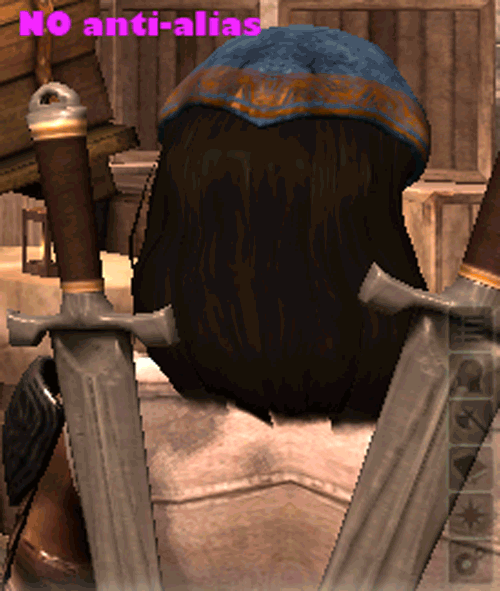Most modern games have the ability to change the anti-alias settings. However, lots of us have no idea what the anti-alias settings actually do. What is FSAA? Do you need 2x, 4x, 8x, or more? Learn why you may be able to safely lower this setting an increase your frame rate. End your world of aliasing artifact jagged confusion.
Since the earliest days of computer graphics, alias artifacts have existed. An alias artifact occurs when what should be a straight line is actually rendered with an unnatural, jagged appearance.
See all the unnatural, jagged lines in this example of alias artifact:
At lower screen resolutions, alias artifact is often more apparent. Alias is one of the most obvious visual clues that an object has been computer generated.
Anti-aliasing are algorithms used to blend and hide alias artifact. Typically this consists of blurring and shading the line to make it appear more smooth and natural.
Here is the above scene rendered with anti-aliasing enabled:
The multiplier reference (such as 2x, 4x, 8x, or more) is simply how many samples are taken around the alias artifact to assist with the rendering of the smoothing anti-alias effect. More samples yield better smoothing techniques; however, the additional processing will decrease performance and thus yield lower frames per second.
As screen resolutions increases, the alias artifacts become smaller. With higher resolutions, the basic unit that the computer renders is smaller. Smaller render units equals smaller jags.
With higher resolutions, anti-alias becomes less important to the visual appearance of the game. Additionally, many people can not perceive the difference in the higher anti-alias effect multipliers. Often 2x, for example, is adequate sampling and increasing the multiplier just decreases frame rates without providing much visual improvement. Increasing anti-alias one multiplier step (2x to 4x, for example) often will drop performance as much 2-5 fps.
FSAA stands for Full Screen Anti-Alias. This is a specific anti-alias technique that scans and corrects the entire screen for alias artifacts. However, it is often used synonymously with any “anti-aliasing” techniques used in gaming.
Anti-aliasing techniques are essential in making games more realistic. They smooth out all the jagged edges that are common in computer-generated graphics. However, anti-alias techniques do adversely affect fps performance. As resolutions increase, the amount of anti-alias needed decreases. Decreasing the anti-alias multiplier often causes very little decrease in visual realism. Less anti-alias will increase fps yielding a smoother, more fluid experience.



